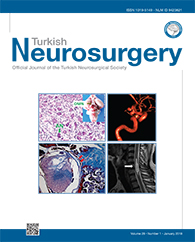2Eskisehir Osmangazi University, School of Medicine, Department of Physiology, Eskişehir, Turkey
3Eskisehir Osmangazi University, School of Medicine, Department of Medical Biology, Eskisehir, Turkey
4Eskisehir Osmangazi University, School of Medicine, Department of Biostatistic, Eskisehir, Turkey DOI : 10.5137/1019-5149.JTN.18072-16.1 AIM: To describe the relationship between the parenchymal pressure changes and the development of hydrocephalus in kaolininjected neonatal rats according to cerebral regions and time intervals of developing hydrocephalus.
MATERIAL and METHODS: Neonatal rats aged 2 to 3 days were examined in 5 groups as kaolin frontal "K-F", kaolin parietal "KP", saline frontal "SF-F", saline parietal "SF-P" and control "C", based on the injected material and injection sites. All injections were performed into the cortical subarachnoid space of the right frontal and right parietal regions. The fifth group was injection free. On the 3rd, 7th, 15th, 30th and 60th days after injection, parenchymal pressures (PP) of 5-7 rats from each group were measured from different regions.
RESULTS: We compared the control group with saline-injected and kaolin-injected groups and found statistically significant parenchymal pressure differences based on regional measurements. In the kaolin groups, the mean PP values were obviously higher than the saline-injected group. Within each kaolin-injected group, the pressure values were variable and inconsistent regarding the parenchymal regions.
CONCLUSION: Hydrocephalus cannot be totally explained with existent "bulk-flow" or "hydrodynamic" theories. Although our experimental design was planned to develop hydrocephalus according to the bulk flow theory, our results were more compatible with the hydrodynamic theory. The present comments on the occurrence and pathogenesis of hydrocephalus are still open to debate and may require further comprehensive studies.
Keywords : Cerebrospinal fluid, Hydrocephalus, Experimental, Newborn rat, Parenchymal pressure




